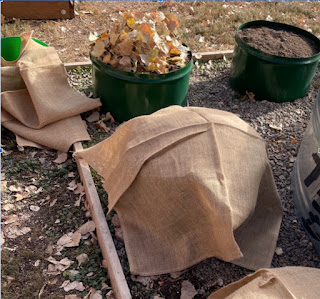by Angela K. Nickerson, Colorado Master Gardener - Broomfield County
I have one neighbor who feeds the squirrels – daily putting out pounds of peanuts for them which I find buried in my garden blocks away. Another neighbor is absolutely at war with the squirrels doing everything she can to discourage them from entering her yard. Me? They are a bit of a nuisance in my opinion, but we are largely friendly with one exception: bulbs. It's infuriating to find my freshly-planted spring bulbs scattered about the yard, the remnants of a bacchanalian rodent feast. However, last year I was determined to outwit the squirrels, and of all the bulbs I planted last year, the squirrels ate exactly ZERO.
I was a little late in planting my bulbs last fall, and I happened to hear an interview with Dr. Lucia Jacobs, a professor at UC Berkeley who studies squirrel behavior. She said that squirrels watch each other bury nuts, and then go to dig them up in a competitive game of hoarding each fall. They also watch us when we are planting bulbs, and freshly-dug earth is like an X marking the spot for a squirrel.
I thought a lot about that. And then I devised a plan to outwit my squirrely neighbors. And it worked!
Squirrel-Proof Bulb Planting Materials:
burlap yardage or squares
landscape staples
mallet or hammer
trug or bucket for collecting leaves
fallen leaves
bulbs
trowel
1. Plant the bulbs in bunches of 5-6 bulbs (or more depending on what you are planting). Plant them according to the species and at the appropriate depth. Cover with soil. For more information, check out this resource.
2. Cover each planting area with a trug-full of fallen leaves. This is a great mulch and insulation.
3. Cover the leaves with a square of burlap. Secure the burlap to the ground with landscape staples – drive them in with a mallet or hammer.
Water each spot well, and continue to water on warm days during the winter when we haven't had recent precipitation or snow cover – generally 1-2 times per month on a day that is above 45°F.
Uncover your bulbs in early March (or even February if you planted very early bloomers). Chances are early bloomers will be emerging under the burlap. There's no need to clear away the leaves. They will have begun to decompose over the winter and will provide a little insulation from cold temperatures. The burlap can be washed and stored away or composted.
I planted tulips in these containers and used the same method to cover them. It worked perfectly!
Spring bulbs bring cheer and promise in those early days as we emerge from a cold winter, and they provide early food for some insects as well. Many including daffodils, muscari, and crocus are perennial, and since they aren't dug up year-to-year, you'll only need to cover them the year they are first planted to outsmart your squirrelly neighbors.


No comments:
Post a Comment